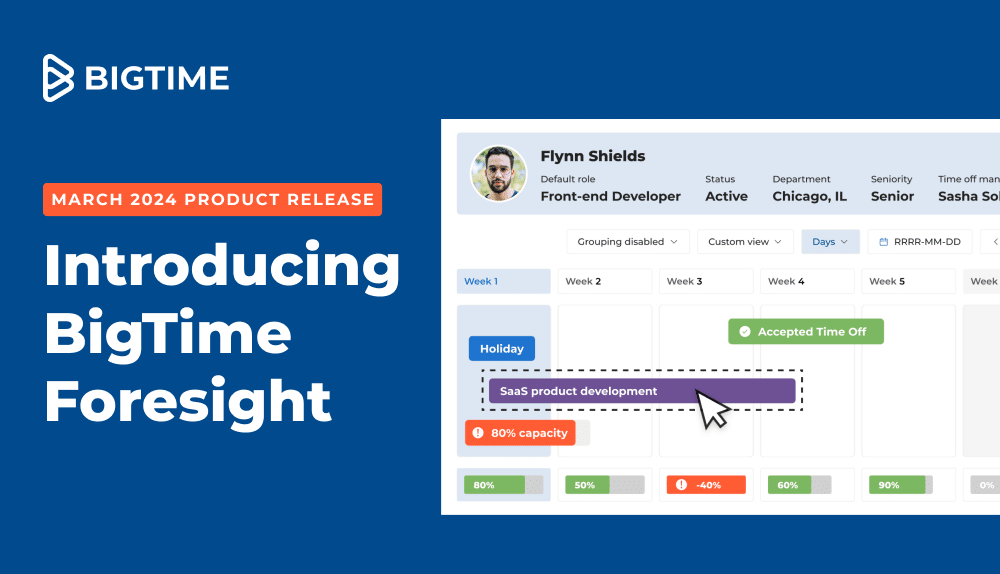
Using Predictive Analytics to Forecast Project Management and Budget to Improve Delivery
Delivering project-based services that exceed client expectations is complex, demanding, and high stakes. Project managers need to deliver on-time and on-budget, yet projects often change course mid-stream and unforeseen challenges go unnoticed without properly being able to forecast project management.
So how do teams stick to a project budget and project schedule that is constantly in flux with shifting client expectations and dependencies? Next-generation services teams leverage predictive analytics to forecast project management and anticipate project shifts so they can take proactive measures and better serve their clients.
Project management forecasting, workstream forecasting, and budget forecasting are three examples of how predictive analytics can be leveraged to deliver better project experiences.
Predictive Analytics Overview
Predictive analytics uses modeling and statistics to determine future performance based on current and historical data. There are several applications across industries, such as financial services, retail, manufacturing, and health insurance. Predictive analytics continues to become more prominent, with a global market projected to reach $10.95 billion by 2022, according to a Zion Market Research report.
Predictive analytics is seldom discussed in the services industry, yet the impact is substantial when leveraged correctly, leading to better cost estimation and budget forecasting in project management and improved resource utilization. Project-based teams consequently receive more help to hit their profit and utilization targets.
Forecast Project Management to Reduce Uncertainties
Most organizations have some method of forecasting their work, but visibility and accuracy typically declines further ahead into the future. Predictive analytics enables organizations to monitor their forecasts in tandem with their historical performance, analyze variance and variation, and refine predictions on a consistent basis. By making this forecasting data visible and accessible, service teams are empowered with the data they need, when they need it.
Consequently, leaders can understand in advance if they have the teams and capabilities required to take on another project, or if their pipeline is oversold. Better planning leads to better client outcomes and a more satisfying customer experience. Project management forecasting software provides the ability to reduce project-based uncertainties, allowing service organizations to improve performance and realize increased returns.
Resource Planning in Project Management Forecasting
When you forecast project management via predictive analytics with resource scheduling software, it unlocks insights into resource plans across multiple projects into the future. As task-level workstreams are translated into high-level resource management plans, delivery managers have the ability to understand if they will hit utilization targets, profit margins, and overall performance goals. At the same time, leaders receive real-time operational and financial data that provides reliable revenue and headcount projections to easily scale their organization.
Bonus: Download a FREE guide for strategies on how to forecast project management using the metrics that matter to professional services organizations.
Forecast Project Management vs. Budget
A budget and a forecast are not the same concept. As summarized by Investopedia, “Budgeting quantifies the expectation of revenues that a business wants to achieve for a future period, whereas financial forecasting estimates the number of revenues that will be achieved in a future period.”
Budget forecasting and planning in project management typically takes place during the proposal process to ensure project profitability and accurate client pricing. As costs are incurred, the project manager updates the project budget template. While this sounds easy, it becomes challenging to put into practice.
As project dependencies and scope creep interfere, project budget forecasting, management and tracking often becomes a reactive process. The tricky aspect is predicting where the actual project budget will land in the future, based on where the project stands today. This type of accurate budget forecasting is what delivery teams strive for.
Project Budget Forecasting
Project budgeting and budget forecasting software empowers services teams to leverage predictive analytics to calculate a budget’s estimate-at-completion, in addition to actuals-to-date. These early indicators for project performance inform project cost estimation and budgeting for the remainder of the client contract. As a result, services teams have an improved ability to impact the success of present and future projects.
Project and project portfolio managers have the ability to predict the final outcome of a project when they forecast project management, workstream and resourcing needs along with the foreseeable incurred costs. An on-time, under-budget project leads to happy clients.
Summary
Organizations need the ability to gather accurate, clean, and consistent data in order to best leverage predictive analytics to successfully forecast project management.
If your organization is not already leveraging predictive analytics to forecast project management, there is a huge opportunity to gain from tracking team performance, resource allocation, and organizational goals over time. By utilizing this technology to forecast the unpredictable, project managers and service teams can deliver projects faster and with greater accuracy.
Fortunately, there is technology that is specifically built for service-based organizations that can be used as a forecasting tool, such as Professional Services Automation (PSA) software. PSA software provides this data as a single source of the truth.
A purpose-built PSA solution not only acts as a platform for predictive analytics, but it also helps organizations exceed their client expectations by giving team members confidence that they understand what it will take to make a client contract successful with fewer unexpected mishaps. It gives them the ability to act on the data and proactively address issues to improve the rewards of their project management.
Have questions or want to learn more? Our team is here to help.
Frequently Asked Questions About How to Forecast Project Management
What is forecasting in project management?
Forecasting in project management provides the ability to reduce project-based uncertainties. Predictive analytics enables organizations to monitor their project forecasts in tandem with their historical performance, analyze variance and variation, and refine predictions on a consistent basis.
What is predictive analytics?
Predictive analytics uses modeling and statistics to determine future performance based on current and historical data.
What is predictive project analytics?
Next-generation services teams leverage predictive analytics to forecast project management and anticipate project shifts so they can take proactive measures and better serve their clients.
What are three examples of predictive analytics in projects?
Project management forecasting, workstream forecasting, and budget forecasting are three examples of how predictive analytics can be leveraged to deliver better project experiences.
What is budgeting and forecasting in project management?
A budget and a forecast are not the same concept. As summarized by Investopedia, “Budgeting quantifies the expectation of revenues that a business wants to achieve for a future period, whereas financial forecasting estimates the number of revenues that will be achieved in a future period.”
What is financial forecasting in project management?
Financial forecasting in project management is leveraging predictive analytics to anticipate project shifts and determine future performance based on current and historical data. This allows service teams to take proactive measures, improve resource utilization and cost estimation, and better serve their clients.


.png)


